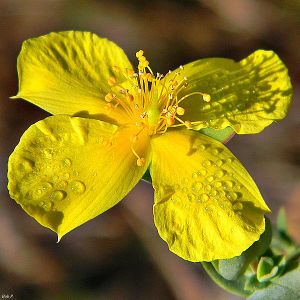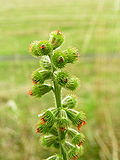Note: This is a project under development. The articles on this wiki are just being initiated and broadly incomplete. You can Help creating new pages.
Difference between revisions of "Hypericum perforatum - Klamath Weed"
m (Prabhakar moved page Klamath Weed (Hypericum perforatum) to Hypericum perforatum - Klamath Weed) |
|||
| Line 1: | Line 1: | ||
[[File:Springtime St. John's Wort (12610079565).jpg|thumb|right|''Klamath Weed'', ''Springtime St. John's Wort'']] | [[File:Springtime St. John's Wort (12610079565).jpg|thumb|right|''Klamath Weed'', ''Springtime St. John's Wort'']] | ||
| − | |||
The common name '''"St John's wort"''' may be used to refer to any species of the genus Hypericum. Therefore, Hypericum perforatum is sometimes called "common St John's wort" or "perforate St John's wort" in order to differentiate it. | The common name '''"St John's wort"''' may be used to refer to any species of the genus Hypericum. Therefore, Hypericum perforatum is sometimes called "common St John's wort" or "perforate St John's wort" in order to differentiate it. | ||
| Line 6: | Line 5: | ||
Studies have supported the efficacy of St John's wort as a treatment for depression in humans | Studies have supported the efficacy of St John's wort as a treatment for depression in humans | ||
| − | ==Common name== | + | ==Uses== |
| + | {{Uses|Wounds}}, {{Uses|Cuts}}, {{Uses|Snakebites}}, {{Uses|Curing liver disorders}}, {{Uses|Skin eruptions}}, {{Uses|Blotches}}, {{Uses|Pimples}}, {{Uses|Diarrhea}}, {{Uses|Sore throats}} | ||
| + | |||
| + | ==Parts Used== | ||
| + | {{Parts Used|Dried Folaige}}, {{Parts Used|Whole herb}}. | ||
| + | |||
| + | ==Chemical Composition== | ||
| + | The major constituents of the essential oils were α-pinene (12.52–49.96%), β-pinene (6.34–9.70%), (E)-β-ocimene (4.44–12.54%), β-caryophyllene (1.19–5.67%), and germacrene-D (2.34–6.92%).<ref name="chemical composition"/> | ||
| + | |||
| + | ==Common names== | ||
| + | {{Common names|kn=|ml=|sa=|ta=|te=|hi=|en=Agrimony}} | ||
| + | |||
| + | ==Properties== | ||
| + | Reference: Dravya - Substance, Rasa - Taste, Guna - Qualities, Veerya - Potency, Vipaka - Post-digesion effect, Karma - Pharmacological activity, Prabhava - Therepeutics. | ||
| + | ===Dravya=== | ||
| + | |||
| + | ===Rasa=== | ||
| + | |||
| + | ===Guna=== | ||
| + | |||
| + | ===Veerya=== | ||
| + | |||
| + | ===Vipaka=== | ||
| + | |||
| + | ===Karma=== | ||
| + | |||
| + | ===Prabhava=== | ||
| + | |||
| + | ==Habit== | ||
| + | {{Habit|Herb}} | ||
| + | |||
| + | ==Identification== | ||
| + | ===Leaf=== | ||
| + | {{Leaf|Simple||leaves shape is lobed or unlobed but not separated into leaflets}}<ref name="Leaf"/> | ||
| + | |||
| + | ===Flower=== | ||
| + | {{Flower|Unisexual|2-4cm long|Yellow|13|there are two or more ways to evenly divide the flower}} | ||
| + | |||
| + | ===Fruit=== | ||
| + | {{Fruit|general|3–6.5 mm|clearly grooved lengthwise, Lowest hooked hairs aligned towards crown|With hooked hairs|many}} | ||
| + | |||
| + | ===Other features=== | ||
| + | |||
| + | ==List of Ayurvedic medicine in which the herb is used== | ||
| + | * [[Vishatinduka Taila]] as ''root juice extract'' | ||
| + | |||
| + | ==Where to get the saplings== | ||
| + | ==Mode of Propagation== | ||
| + | {{Propagation|Seeds}}, {{Propagation|Cuttings}}. | ||
| + | |||
| + | ==How to plant/cultivate== | ||
| + | Easily grown in any reasonably good well-drained but moisture retentive soil<ref name="How to plant/cultivate"/> | ||
| + | |||
| + | ==Commonly seen growing in areas== | ||
| + | {{Commonly seen|Open woods}}, {{Commonly seen|hedgebanks}}, {{Commonly seen|grassland}}, {{Commonly seen|dry sunny places}}, {{Commonly seen|calcareous soils}}. | ||
| + | ==Photo Gallery== | ||
| + | <gallery class="left" caption="" widths="140px" heights="140px"> | ||
| + | File:Odermennig.jpg | ||
| + | File:Agrimonia eupatoria02.jpg | ||
| + | Image:Agrimonia eupatoria MHNT.BOT.2004.0.jpg | ||
| + | </gallery> | ||
| + | |||
| + | ==References== | ||
| − | + | <references> | |
| − | + | <ref name="chemical composition">[https://www.tandfonline.com/doi/full/10.3109/13880209.2013.821663 "constituents"]</ref> | |
| − | = | + | <ref name="Leaf">[https://gobotany.newenglandwild.org/species/hypericum/perforatum/ "plant charecteristics"]</ref> |
| − | + | <ref name="How to plant/cultivate">[https://www.pfaf.org/user/Plant.aspx?LatinName=Hypericum+perforatum "Cultivation details"]</ref> | |
| + | </references> | ||
| + | ==External Links== | ||
| + | * [http://www.missouribotanicalgarden.org/PlantFinder/PlantFinderDetails.aspx?kempercode=e198 Hypericum perforatum on missouri botonical garden] | ||
| + | * [https://link.springer.com/article/10.1007/BF03030606 Chemical Constituents of SomeHypericum Species Growing in Turkey] | ||
| + | * [https://keyserver.lucidcentral.org/weeds/data/media/Html/hypericum_perforatum.htm Hypericum perforatum on keyserver.lucidcentral.org] | ||
| + | * [https://www.sciencedirect.com/topics/neuroscience/hypericum-perforatum Hypericum perforatum on science direct] | ||
[[Category:Herbs]] | [[Category:Herbs]] | ||
Revision as of 11:33, 17 May 2018
The common name "St John's wort" may be used to refer to any species of the genus Hypericum. Therefore, Hypericum perforatum is sometimes called "common St John's wort" or "perforate St John's wort" in order to differentiate it.
Studies have supported the efficacy of St John's wort as a treatment for depression in humans
Contents
[hide]- 1 Uses
- 2 Parts Used
- 3 Chemical Composition
- 4 Common names
- 5 Properties
- 6 Habit
- 7 Identification
- 8 List of Ayurvedic medicine in which the herb is used
- 9 Where to get the saplings
- 10 Mode of Propagation
- 11 How to plant/cultivate
- 12 Commonly seen growing in areas
- 13 Photo Gallery
- 14 References
- 15 External Links
Uses
Wounds, Cuts, Snakebites, Curing liver disorders, Skin eruptions, Blotches, Pimples, Diarrhea, Sore throats
Parts Used
Chemical Composition
The major constituents of the essential oils were α-pinene (12.52–49.96%), β-pinene (6.34–9.70%), (E)-β-ocimene (4.44–12.54%), β-caryophyllene (1.19–5.67%), and germacrene-D (2.34–6.92%).[1]
Common names
| Language | Common name |
|---|---|
| Kannada | |
| Hindi | |
| Malayalam | |
| Tamil | |
| Telugu | |
| Marathi | NA |
| Gujarathi | NA |
| Punjabi | NA |
| Kashmiri | NA |
| Sanskrit | |
| English | Agrimony |
Properties
Reference: Dravya - Substance, Rasa - Taste, Guna - Qualities, Veerya - Potency, Vipaka - Post-digesion effect, Karma - Pharmacological activity, Prabhava - Therepeutics.
Dravya
Rasa
Guna
Veerya
Vipaka
Karma
Prabhava
Habit
Identification
Leaf
| Kind | Shape | Feature |
|---|---|---|
| Simple | leaves shape is lobed or unlobed but not separated into leaflets |
Flower
| Type | Size | Color and composition | Stamen | More information |
|---|---|---|---|---|
| Unisexual | 2-4cm long | Yellow | 13 | there are two or more ways to evenly divide the flower |
Fruit
| Type | Size | Mass | Appearance | Seeds | More information |
|---|---|---|---|---|---|
| general | 3–6.5 mm | clearly grooved lengthwise, Lowest hooked hairs aligned towards crown | With hooked hairs | many | {{{6}}} |
Other features
List of Ayurvedic medicine in which the herb is used
- Vishatinduka Taila as root juice extract
Where to get the saplings
Mode of Propagation
How to plant/cultivate
Easily grown in any reasonably good well-drained but moisture retentive soil[3]
Commonly seen growing in areas
Open woods, hedgebanks, grassland, dry sunny places, calcareous soils.
Photo Gallery
References
External Links
- Ayurvedic Herbs known to be helpful to treat Wounds
- Ayurvedic Herbs known to be helpful to treat Cuts
- Ayurvedic Herbs known to be helpful to treat Snakebites
- Ayurvedic Herbs known to be helpful to treat Curing liver disorders
- Ayurvedic Herbs known to be helpful to treat Skin eruptions
- Ayurvedic Herbs known to be helpful to treat Blotches
- Ayurvedic Herbs known to be helpful to treat Pimples
- Ayurvedic Herbs known to be helpful to treat Diarrhea
- Ayurvedic Herbs known to be helpful to treat Sore throats
- Herbs with Dried Folaige used in medicine
- Herbs with Whole herb used in medicine
- Herbs with common name in English
- Habit - Herb
- Index of Plants which can be propagated by Seeds
- Index of Plants which can be propagated by Cuttings
- Herbs that are commonly seen in the region of Open woods
- Herbs that are commonly seen in the region of hedgebanks
- Herbs that are commonly seen in the region of grassland
- Herbs that are commonly seen in the region of dry sunny places
- Herbs that are commonly seen in the region of calcareous soils
- Herbs



